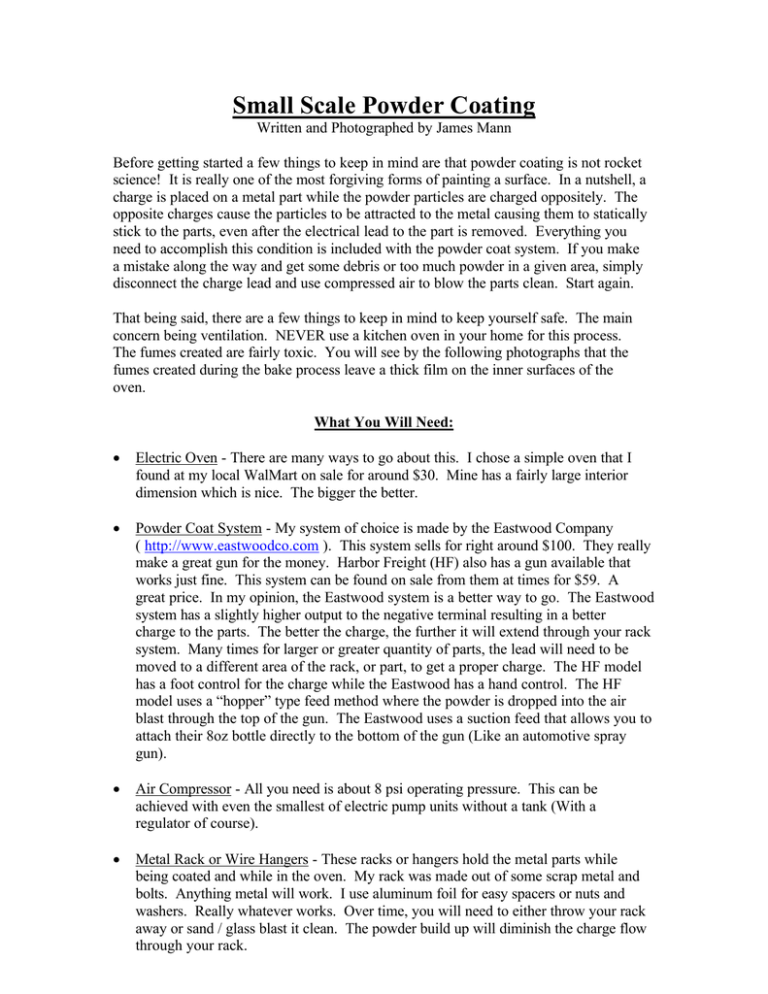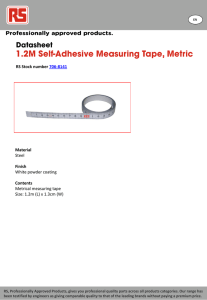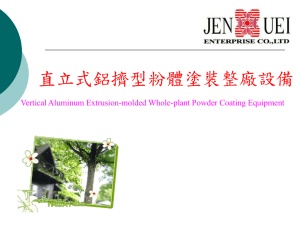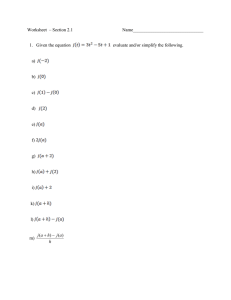Small Scale Powder Coating
advertisement

Small Scale Powder Coating Written and Photographed by James Mann Before getting started a few things to keep in mind are that powder coating is not rocket science! It is really one of the most forgiving forms of painting a surface. In a nutshell, a charge is placed on a metal part while the powder particles are charged oppositely. The opposite charges cause the particles to be attracted to the metal causing them to statically stick to the parts, even after the electrical lead to the part is removed. Everything you need to accomplish this condition is included with the powder coat system. If you make a mistake along the way and get some debris or too much powder in a given area, simply disconnect the charge lead and use compressed air to blow the parts clean. Start again. That being said, there are a few things to keep in mind to keep yourself safe. The main concern being ventilation. NEVER use a kitchen oven in your home for this process. The fumes created are fairly toxic. You will see by the following photographs that the fumes created during the bake process leave a thick film on the inner surfaces of the oven. What You Will Need: • Electric Oven - There are many ways to go about this. I chose a simple oven that I found at my local WalMart on sale for around $30. Mine has a fairly large interior dimension which is nice. The bigger the better. • Powder Coat System - My system of choice is made by the Eastwood Company ( http://www.eastwoodco.com ). This system sells for right around $100. They really make a great gun for the money. Harbor Freight (HF) also has a gun available that works just fine. This system can be found on sale from them at times for $59. A great price. In my opinion, the Eastwood system is a better way to go. The Eastwood system has a slightly higher output to the negative terminal resulting in a better charge to the parts. The better the charge, the further it will extend through your rack system. Many times for larger or greater quantity of parts, the lead will need to be moved to a different area of the rack, or part, to get a proper charge. The HF model has a foot control for the charge while the Eastwood has a hand control. The HF model uses a “hopper” type feed method where the powder is dropped into the air blast through the top of the gun. The Eastwood uses a suction feed that allows you to attach their 8oz bottle directly to the bottom of the gun (Like an automotive spray gun). • Air Compressor - All you need is about 8 psi operating pressure. This can be achieved with even the smallest of electric pump units without a tank (With a regulator of course). • Metal Rack or Wire Hangers - These racks or hangers hold the metal parts while being coated and while in the oven. My rack was made out of some scrap metal and bolts. Anything metal will work. I use aluminum foil for easy spacers or nuts and washers. Really whatever works. Over time, you will need to either throw your rack away or sand / glass blast it clean. The powder build up will diminish the charge flow through your rack. The photo above shows the Eastwood system. Here’s what’s in the box. My Simple Toaster oven. I use the 8oz bottles from Eastwood. You will find that not all powders are created equal. Find a supplier that you like and stick with them. As you can see, for this tutorial, I will be using a high gloss black powder. A Photo of the gun with the 8oz bottle in place. The moisture filter on the gun is included with the Eastwood kit. The intake quick connect was an add on. A look at the transformer that powers the gun. The wire from the top of the unit is the 120 volt AC connector. The gray wire runs to the hand held charge activator. The middle (smaller) wire on the side runs to the charging clip (To be attached to your work). The bottom wire connects to the powder gun. A view of my simple metal rack (You can see that is almost time for another blast job to clean the rack). I will be coating two aluminum pen barrels. Aluminum foil is used as a simple spacer to keep the larger tube from touching the rack. There are high tempt tapes that are used to cover parts that you want to keep free of powder (Threads, etc.). You can see I am running my compressor at right about 10 psi on the (right) gauge. Working psi is around 8. Now the charge lead is connected to the rack. There is no charge being sent at this point. The part is only charged when you activate the charge switch (Hand switch in my case). This is the charge activator / switch. When pressed, the part becomes negatively charged. It should be noted that once I have all of my equipment set up, I preheat my oven to 450 degrees. A shot of the fine powder mist created by the gun. With the hand switch held in, the parts are coated by pulling the trigger on the gun. There is an art to learning how much powder to use. You can get a good feel of the thickness over time. Wind is bad, as it blows the powder away from parts. I have found a slight intermittent breeze to be acceptable. You can coat inside a large cardboard box and collect any over-spray. This can be reused if desired. Once coated, the charging lead is removed from the rack. NOTE: When doing this, unplug the system from the AC first. Then touch the tip of the powder gun to the tip of the charging lead. This will ground the system and save you from a sweet little treat (Shock)! Note the red hot elements. The oven is fully preheated. After about 10 minutes or so, you will see what is called “flow out”. This means simply that the powder has turned into a liquid and flowed smooth. It will not drip. Now it is time to roll the temp down to around 350-375 degrees (Depending on the powder) and set the timer. Down to 350 Degrees it goes. NOTE: These temps are what work well with my system. They should be about right and don’t seem to be too critical. I will say that you can achieve some different effects if the flow is cut short. Useful effects, if you want a little texture to your coating (What I did on this pen). My toaster oven (as most do) has a timer. Around 22 minutes seems to do the trick on the smaller parts. You can see the nasty gasses floating around in there. I use a cross blowing fan to knock the fumes out my garage door. Works very well. I also use a respirator while coating and while standing around the oven. When the timer goes off, I open the door a little and allow the parts to slowly cool. After a short time (5-10 min) I set them on top of the oven to completely cool (about 20 min). After the parts have cooled, the parts are ready for service. The finish is very durable. The clear coat comes out perfectly smooth. There are some blacks that are smoother than others. Mine has a slight texture to it. I like it though as it is still very shiny. If you are not happy with the results at this point, soak the parts in Acetone. After about 5 minutes, the PC will scrape right off with a Acetone Saturated cloth. Some clear powder coated Brass 300 Winchester Magnum casings. I hope that you have found this information to be helpful and thought provoking. That is what sharing of knowledge is all about. This is not meant to be a complete guide, but more of reference. Please use all precautions that you deem to be necessary and stay safe. Cheers!






